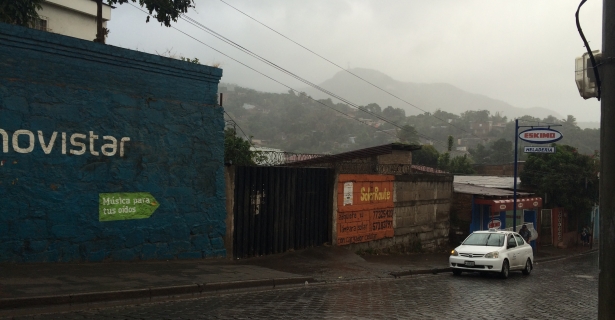Morgan Babbs and James Downer are in the class of 2015 and are Empower fellows.
AUGUST 16, 2014:
I worked up until the last moment I left Nicaragua, getting on the bus and plane with my arms covered in black and orange paint from the promotional mural we were working on. I tried to take a moment to let the feeling of leaving sink in—my first motionless moment in a while—as I felt the bus’ engine start up. Something else caught me though. I felt what I was leaving behind, and that when I’d come back, nothing will have changed—the women with buckets of cosas de horno on their heads, the elderly manning their fruit stands, the frail but strong men coordinating the gate movement of Cotrán Sur, their voices deformed from all the unnatural yelling, the young Nicaraguans, gazing blankly into the street waiting for the sun to go down then come up again so they could do it all again. And there I was lucky enough to be leaving at my own free will. I was going on to my life, leaving behind the same constant motion and chaos that is Cotrán Sur, that is Matagalpa, that is Nicaragua, where the people whose glances I caught as I left would be in the same motion, action, and position that they were in when I left. Life goes on, but the painful inequality before my eyes was that my life was flourished with opportunities to actually go on somewhere and theirs wasn’t. Many people ask me what the driving “why” is behind the path I’ve chosen. This is the why behind what I do and one of the many reasons I am an entrepreneur: I have the resilience, spirit, and power to fix this, so the better question is, why not?
JANUARY 7, 2014:
This time around, I left the airport, waited on the curb for 15 minutes and hopped on the three-hour bus to Matagalpa. I was right back into it, starting off with my least favorite activity: standing bus rides. Right back into it and nothing had changed. As we pulled into Cotrán Sur I felt like I had never left. My predictions, unfortunately, were absolutely correct.
I had always comically imagined that the first thing I’d do upon arrival to Matagalpa would be to visit that mural. As James and I walked up the street to visit William, our Country Director, we refrained from speaking, ready to laugh because we knew what was approaching. We stood in front of our mural for the first time, still surprised and glad by the permanent mark SolarRoute left on the town and laughing reminiscing how the whole painting stunt came about on a whim. No one painted over it, no one even tagged it. It was exactly how we left it, just like everything else in Matagalpa. We were so eager to see the mural—comic because it’s as if that was our lasting impact from the summer, rather than the 120 solar light/cell-charger units we sold and distribution networks we built. It made me feel bittersweet and I kept looking back, smiling, as we walked away from it. I could almost see James and William and myself sitting there in the early hours of the morning in harsh sunlight for three days straight scrubbing down the wall, painting layers of orange, holding up stencils, and struggling when we’d get caught in the rain. It took a certain audacity to approach a stranger and ask to paint their wall. But this spirit and boldness really characterized our entire SolarRoute pilot.
Nothing had changed in Matagalpa. My thoughts during my departure in August were still fresh in my mind and I felt bittersweet standing in front of the mural because I thought of how much my life had changed in the past five months back at Tufts, because my world was flourished with opportunity. And while, yes, this saddened me, just like it did in August, this time around it was extremely fulfilling to see one thing stay the same. Our SolarRoute agents were still going, still selling, as if I had never gone back to school. It reminded of what we built, the potential, and what we still have left to accomplish, but most importantly, my “why” behind why I started SolarRoute.

